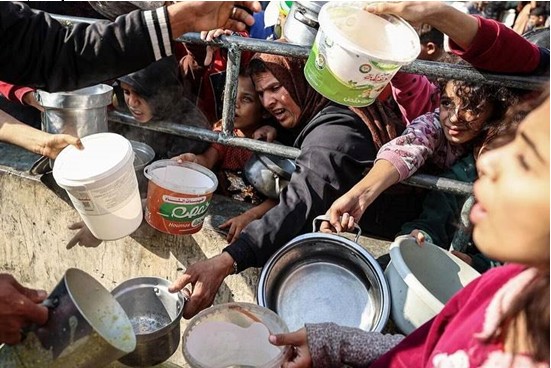**
At least 66 per cent of employment has been lost in Gaza since hostilities erupted on 7 October, equivalent to 192,000 jobs, revised estimates by the International Labor Organization (ILO) and the Palestinian Central Bureau of Statistics (PCBS) indicate in their second bulletin published Wednesday. The continuing hostilities are also increasingly impacting economic conditions in the occupied West Bank, where revised estimates now indicate that around 32 per cent of employment has been lost since 7 October, equivalent to 276,000 jobs.

The suffering of the Palestinian families displaced as a result of the ongoing Israeli war on Gaza (Photo: WAFA)
All in all, a total 468,000 jobs are estimated to have been lost across the Occupied Palestinian Territory (OPT) as of 30 November 2023, which supersedes the previous ILO and PCBS estimate of 390,000 jobs expected to be lost due to the ongoing hostilities. These job losses translate into daily labour income losses of $20.5 million US dollars, the second bulletin on the impact the escalation of hostilities in Gaza has had on the labour market and livelihoods in the OPT estimates.
The bulletin projects the unemployment rate in the OPT to increase from 24 per cent in the 4th quarter of 2022 to a staggering 46.1 per cent in the fourth quarter of 2023, which is set to compound the already devastating humanitarian and economic situation especially in Gaza.
“The Palestinians of Gaza are in the midst of a humanitarian catastrophe of epic proportions,” said ILO Regional Director for Arab States Ruba Jaradat.” The repercussions on the lives and livelihoods of affected communities are beyond anything seen in the Occupied Palestinian Territory before. The economic, social and development impact also has grave cascading implications for the labour market, not only in Gaza but also in the West Bank,” Jaradat said.
“The ongoing war has significantly impacted all aspects of life, resulting in a humanitarian, social and economic crisis,” said PCBS President Ola Awad. “The crisis has caused a huge distortion in the Palestinian economic structure. The unemployment rate in the Gaza Strip now exceeds three-quarters of the labor force, and around a third of the West Bank’s labor force is unemployed, reaching the highest level of unemployment in decades,” Awad said. The escalation of hostilities has resulted in a scarcity of basic necessities for the Gaza population. “The Palestinians of Gaza face severe shortages of food, water and shelter, leading to an almost complete destruction of the economic cycle, and causing the Palestinian economy to lose more than one-third of its production base,” Awad explained.
The bulletin projects that employment will decline in all economic sectors, with the exception of the agricultural sector, where employment is forecast to remain stable and provide a cushioning effect from the loss of employment from other sectors.
Even prior to the current conflict, the situation in the blockaded Gaza enclave was particularly dire. Gazans have long grappled with persistently high rates of poverty, vulnerability and one of the highest unemployment rates in the world. “The escalation of hostilities in Gaza not only exacerbates pre-existing challenges but has led to a profound destruction of all aspects of life in the Strip, rendering it essentially uninhabitable,” the bulletin notes.
Bulletin “Impact of the escalation of hostilities in Gaza on the labour market and livelihoods in the Occupied Palestinian Territory”:
Related: https://maki.org.il/en/?p=31455


